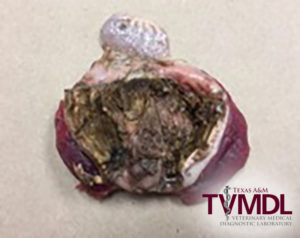Lead poisoning in guinea fowl
By Martin Ficken, DVM, PhD
One live male guinea fowl was presented to the Texas A&M Veterinary Medical Diagnostic Laboratory (TVMDL) for necropsy. History noted the bird was bright and alert, but moved very little, appeared cold and very thin – only weighing 514 grams.
Upon evaluation, marked breast muscle atrophy was present. The bird appeared pale and the blood was thin and watery. The crop was severely dilated and impacted with seed (Figure 1). The gizzard contained dark brownish-black fluid and the koilin layer was necrotic with numerous erosions and was dark in color (Figure 2). Upon further examination, approximately 75 small lead pellets were discovered in the gizzard contents. Representative pellets are included in Figure 3. Additionally, intestinal scrapings demonstrated small numbers of roundworm larvae.
Chronic lead poisoning was the presumptive diagnosis. Due to the presence of lead shot in the gizzard, confirmatory testing of the liver was declined.
Most lead poisoning in birds is chronic. Clinical disease is usually seen as wasting, ataxia, lameness or paralysis, and anemia. In acute cases, anorexia, weakness, prostration, and anemia may be prominent. At necropsy emaciation may be prominent, but if birds die from acute disease, the birds may be in good body condition. The carcass may be pale with watery blood. Erosion and ulceration of the gizzard can be extensive. Impaction of the proventriculus frequently is seen and is likely secondary to vagus nerve damage.
To learn more about this case, contact Gonzales Resident Director Dr. Martin Ficken. For more information about TVMDL’s services and test catalog, visit tvmdl.tamu.edu.
Reference:
Fulton, RM. Toxins and Poisons in Diseases of Poultry 13th edition Wiley-Blackwell, ed. Swayne, DE et al. pp. 1295-1296, 2013.


